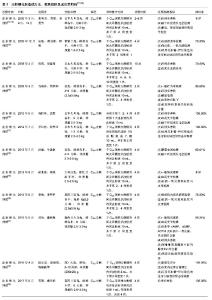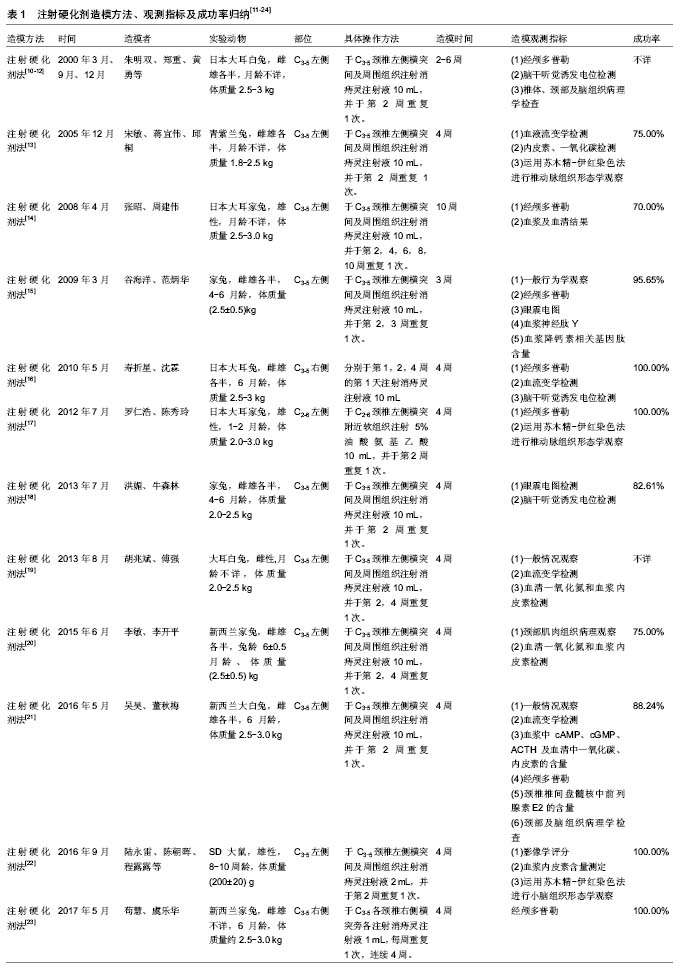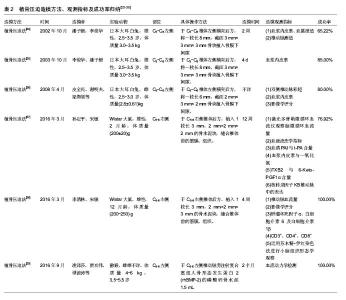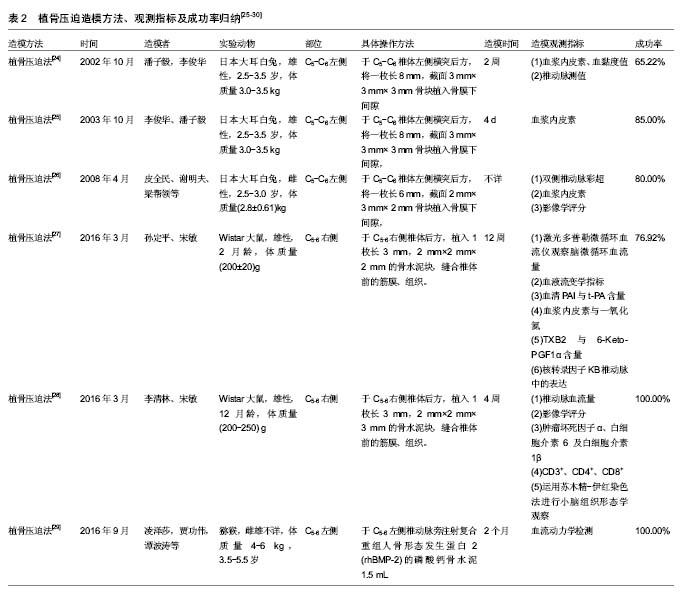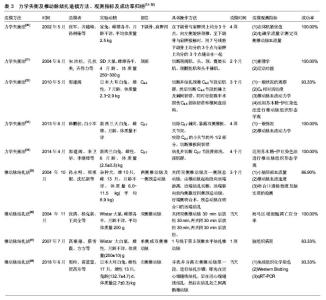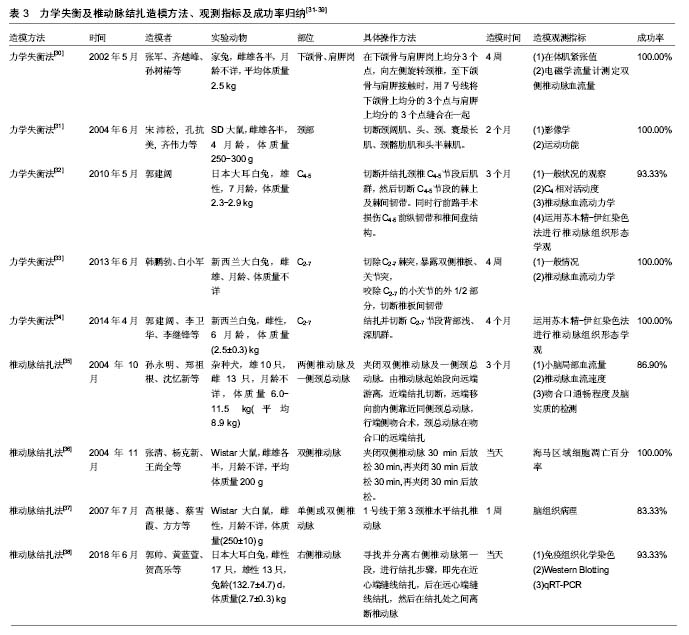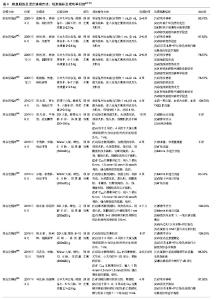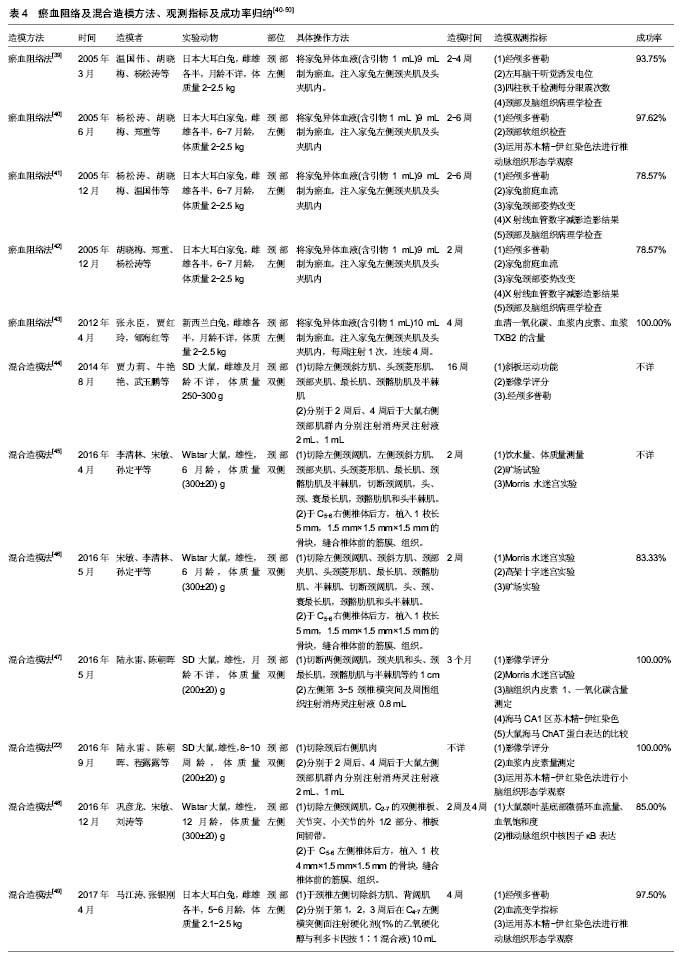| [1] 张翔,邓蓉蓉,强东坤,等.椎动脉型颈椎病中医药治疗研究进展[J].辽宁中医药大学学报,2018,20( 9):120-123. [2] Strek P,Reroń E. A possible correlation between vertebral artery insufficiency and degenerative changes in the cervical spine. Eur Arch Otorhinolaryngol. 1998;255(9): 437-440.[3] Machaly SA,Senna MK,Sadek AG.Vertigo is associated with advanced degenerative changes in patients with cervical spondylosis. ClinRheumatol.2011;30(12):1527-1534.[4] 吕晓兰,杨光福,武变英.颈源性眩晕的研究概况[J].中国实用医药, 2013,8(9):237-238.[5] 王德利,杨敏杰,刘碧波,等.颈椎病患者血浆内皮素的变化[J].西安医科大学学报,2001,22(2):186-188.[6] 徐凯,高海燕,程慧,等.正清风痛宁穴位注射对颈性眩晕患者体液因子的影响[J].新中医,2013,45(6):51-53.[7] 伍海昭,林列,朱加德,等.椎动脉型颈椎病血浆ET、NO的变化[J].中医正骨, 2004, 16(2):3-4.[8] 赵明宇.颈椎早期退行性变的X线表现与颈椎病发病关系的研究[D],济南:山东中医药大学,2003.[9] Morinaka S. Musculoskeletal diseases as a causal factor of cervical vertigo. Auris Nasus Larynx.2009;36(6):649-654.[10] 朱明双,郑重,黄勇,等.注射硬化剂法制作家兔颈椎病椎动脉型动物模型[C]//第五次全国中西医结合骨伤科学术交流会.2000.[11] 朱明双,郑重,黄勇,等.家兔椎动脉型颈椎病模型制作的实验研究-经颅多谱勒检测[J].海南医学院学报,2000,6(3):134-137.[12] 朱明双,郑重,黄勇,等.注射硬化剂法制作家兔颈椎病椎动脉型模型-脑干听觉诱发电位实验研究[J].成都中医药大学学报, 2000, 23(3):42-44.[13] 宋敏,蒋宜伟,邱桐.活血定眩丸对椎动脉型颈椎病兔血液流变学、ET、NO的影响[J].甘肃中医学院学报,2005,22(6):23-27.[14] 张昭.电针对椎动脉型颈椎病模型兔血浆内皮素、血清超氧化物歧化酶影响的研究[D].成都:成都中医药大学,2008.[15] 谷海洋.颈部推拿对椎动脉型颈椎病模型家兔作用的实验研究[D].杭州:浙江中医药大学,2009.[16] 寿折星.复方川脊方治疗椎动脉型颈椎病兔动物模型作用及机制研究[D].武汉:华中科技大学,2010.[17] 罗仁浩,陈秀玲.电针对家兔颈性眩晕模型的实验研究[J].新中医, 2012(7):150-151.[18] 洪媚,牛森林.百会穴长时间留针法对颈性眩晕家兔椎-基底动脉供血的影响[J].中国中医药科技, 2013,20(4):332-333.[19] 胡兆斌,傅强.通络定眩方对椎动脉型颈椎病兔血液流变学、ET、NO的影响[J].实用临床医药杂志,2013,17(15):1.[20] 李敏.针刀疗法对椎动脉型颈椎病兔血清一氧化氮和血浆内皮素的影响[D].南京:南京中医药大学, 2015.[21] 吴昊.通督活血汤干预椎动脉型颈椎病模型兔实验研究[D].呼和浩特:内蒙古医科大学,2016.[22] 陆永雷,陈朝晖,程露露,等.三种椎动脉型颈椎病动物模型的比较研究[J].中医药临床杂志,2016(9):1266-1268.[23] 苟慧.椎动脉型颈椎病(CSA)家兔模型的交感神经逆行追踪和荧光组化学研究[D].重庆:重庆医科大学,2017.[24] 潘子毅,李俊华.壮颈康复剂治疗实验性椎动脉受压的研究[J].中国中医骨伤科杂志,2002,10(5):31-33.[25] 李俊华,潘子毅.椎动脉受压动物模型血浆内皮素的变化[J].中国中医骨伤科杂志, 2003,11(5):16-18.[26] 皮全民,谢明夫,梁帮领.椎动脉型颈椎病动物模型的建立[J].当代医学,2008,139(7): 30-31.[27] 孙定平.活血定眩胶囊对CSA模型大鼠血管功能影响的实验研究[D]. 兰州:甘肃中医药大学,2016.[28] 李清林.活血定眩胶囊对CSA模型大鼠外周血TNF-α、IL-6、IL-1β及T淋巴细胞亚群CD3~+、CD4~+、CD8~+的影响及机制研究[D].兰州:甘肃中医药大学,2016.[29] 凌泽莎,贾功伟,谭波涛,等.注射复合rhBMP-2骨水泥制作猕猴椎动脉型颈椎病模型[J].中山大学学报(医学科学版), 2016,37(5): 775-780.[30] 张军,齐越峰,孙树椿.家兔颈椎两侧肌肉平衡失调对椎动脉血流的影响[J].中国骨伤,2002,15(5):280-281.[31] 宋沛松,孔抗美,齐伟力,等.肌力失衡与后柱失稳大鼠颈椎病模型的研究[J].汕头大学医学院学报,2004, 17(2):70-71.[32] 郭建阔.椎动脉供血不全动物模型的建立及颈性眩晕发病机制的探讨[D].郑州:河南大学,2010.[33] 韩鹏勃,白小军.颈椎失稳对椎动脉血流影响的兔动物实验研究[J].吉林医学,2013,34(17):3299-3300.[34] 郭建阔,李卫华,李继锋,等.椎动脉型颈椎病动物模型的病理学研究[J].中外医疗,2014,33(4):35-36.[35] 孙永明,郑祖根,沈忆新,等.椎动脉闭塞血管重建术改善近、远期后脑区域血供的实验研究[J].中国组织工程研究, 2004,8(29): 6424-6425.[36] 张清,杨克新,王尚全,等.流式细胞仪检测椎动脉型颈椎病动物模型脑神经细胞凋亡[J].中国骨伤,2004,17(11):689-690.[37] 高根德,蔡雪霞,方方,等.椎动脉缺血后大鼠脑组织的组织学改变[J].中国中医骨伤科杂志,2007,15(7):32-34.[38] 郭帅,黄蓝萱,贺高乐,等.兔单侧椎动脉结扎致颈髓急性缺血改变的研究[J].中国脊柱脊髓杂志,2018,28(06):541-551.[39] 温国伟,胡晓梅,杨松涛,等.应用瘀血阻络理论复制家兔椎动脉型颈椎病模型[J].成都中医药大学学报,2005,28(1):49-51.[40] 杨松涛,胡晓梅,郑重,等.一个新的椎动脉型颈椎病家兔动物模型的建立--TCD对CSA模型形成、发展及变化的评价[J].中药药理与临床,2005,21(6):84-86.[41] 杨松涛,胡晓梅,温国伟,等.应用瘀血阻络的方法建立家兔新的CSA动物模型[J].世界科学技术-中医药现代化, 2005,7(S1): 37-41.[42] 胡晓梅,郑重,杨松涛,等.采用瘀血阻络的方法建立新的椎动脉型颈椎病动物模型[J].四川中医,2005,23(12):19-22.[43] 张永臣,贾红玲,郇海红,等.项七针对椎动脉型颈椎病大兔模型血清一氧化氮、血浆内皮素、血栓素B2含量的影响[J].吉林中医药,2012,32(4):391-392.[44] 贾力莉,牛艳艳,武玉鹏,等.大鼠椎动脉型颈椎病模型的建立[C].第十二届中国北方实验动物科技年会论文集.2014:197-200.[45] 李清林,宋敏,孙定平,等.椎动脉型颈椎病大鼠模型的建立与评价[J].辽宁中医杂志,2016,43(04):861-864.[46] 宋敏,李清林,孙定平,等.3种椎动脉型颈椎病大鼠模型的建立与评价[J].西安交通大学学报(医学版),2016,37(03):455-459.[47] 陆永雷.椎动脉型颈椎病模型大鼠记忆功能障碍的机制研究[D].合肥:安徽中医药大学,2016.[48] 巩彦龙,宋敏,刘涛,等.3种方法评价椎动脉型颈椎病大鼠模型[J].暨南大学学报(自然科学与医学版),2016,37(6):497-502.[49] 马江涛.加味半夏白术天麻汤治疗痰瘀互结型椎动脉型颈椎病的实验研究[D].郑州:河南中医药大学,2017.[50] Cloud GC,Markus HS.Diagnosis and management of vertebral artery stenosis.QJM.2003;96(1):27-54[51] Yang L, Yang C, Pang X, et al. Mechanoreceptors in Diseased Cervical Intervertebral Disc and Vertigo.Spine. 2017; 42(8):1.[52] Peng B. Cervical Vertigo: Historical Reviews and Advances. World Neurosurgery. 2018; 109:347. |
